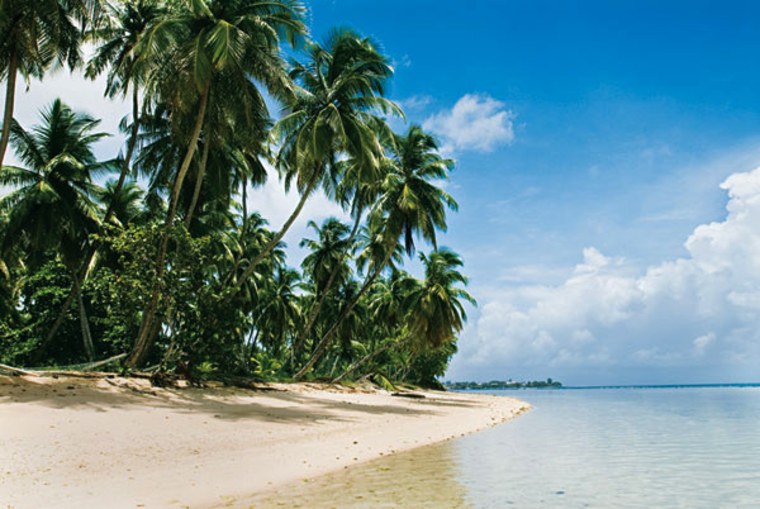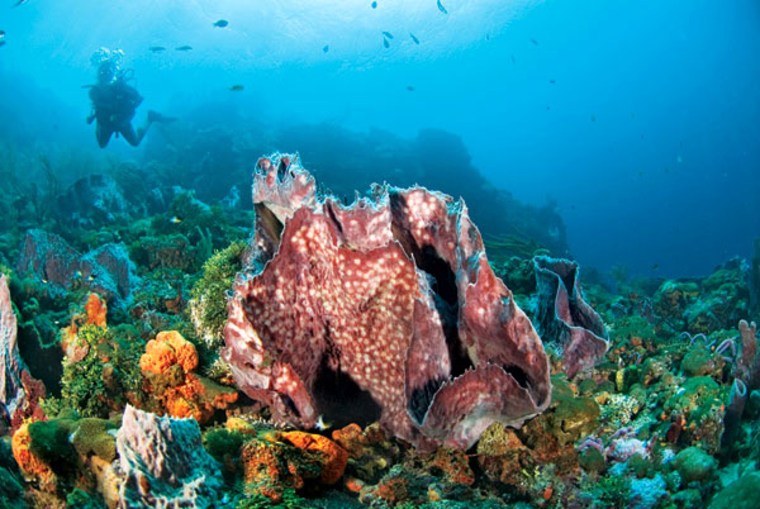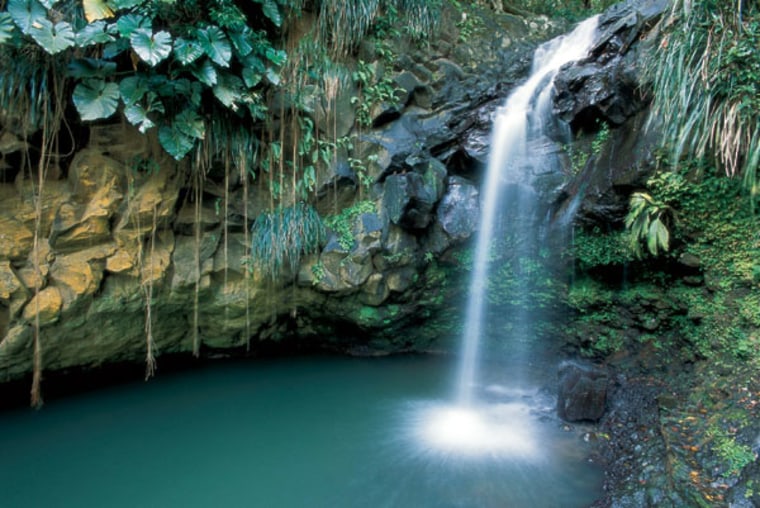When you drill down to the core, it’s the natural things that emerge as the true essentials for a great dive trip: breathe-easy blue skies, make-the-first-track beaches, palm trees, rain forests, reptiles in the crosswalks and — of course — vibrant and teeming marine life and dramatic dive sites. Give me a rain forest, a waterfall, and a coral reef hazed over with blue chromis, and I am one satisfied customer. More and more, when I pack my gear bag, that’s what I go looking for — a natural high with a low latitude.
You say you’re the same way? Well, good news: Five of these natural paragons are right in North America’s big blue backyard — the Caribbean. That means they are easily reachable and they’re eminently affordable.
So what are you waiting for? Book your trip. And pack light … you’re gonna need some extra room for all the memories.
Country Cousin
Tobago, Republic of Trinidad and Tobago
We all have a fondness in our hearts for the country cousin: that simple, straightforward, all-natural soul. And in the skinniest latitudes of the Caribbean, Tobago is that country cousin.
Tobago is the quieter, more natural, laid-back counterpart of cosmopolitan Trinidad. In Trinidad, you drift off to sleep with the sound of dance music lilting in the distance. In Tobago, that music is apt to be replaced by tree frogs, night birds and the hypnotic rustle of leaves.
Moreover, Tobago — farther than Trinidad from the seasonal outflow of Venezuela’s Orinoco River — has what is universally agreed to be the country’s best year-round diving.
One perennial favorite site goes by the less-than-stellar name of “Goat Island Dream.” Part of the draw here is topside — the dive begins next to Goat, a private island, and immediately behind the simple three-level house where Ian Fleming created the James Bond series of novels. Here, after searching in vain for Dr. No and Goldfinger, you can enjoy a reef at 70 feet that is home to nurse sharks, lobsters and — if you can see past their disguises — sea horses, plus a full cast of Caribbean reef fish.

For parties with a mix of divers and snorkelers, Goat Island is great in that one of Tobago’s best snorkeling spots, Angel Reef, is right next door to this dive. Angel is where Fleming would snorkel for an hour every morning before taking his breakfast on a loggia overlooking the sea. And this reef is also home to one of the world’s largest brain corals — a whopper some 16 feet in diameter.
Of course, there are dives in Tobago where nature — not superspies — is the primary draw. One of our favorites is Bookends, named after a pair of islet rocks with a gap between them. Part of the attraction of this dive is watching the waves crashing against the rocks from underneath and wondering how the barracuda and tarpon can hang nearly motionless amid all that turmoil. And part of it is a reef that extends down to about 115 feet. Every green-edged island has to have at least one site that you can dive without using a boat, and Tobago has a couple of beach dives: Arnos Vale Bay, adjacent to the plantation where Princess Margaret honeymooned, is hands-down the best. Barracuda, lobster and octopus abound here, and the topography is varied enough that you can easily split the bay into a pair of one-tank dives.
Currents can be variable around Tobago, though, so it’s best to start a trip here with a PADI operator familiar with conditions. And be sure to budget enough time to explore this beautiful, green place. This is one country cousin with lots of charm.
Spice it Up
Grenada
You may remember Grenada’s three “Spice Islands” of Grenada, Carriacou and Petit Martinique from junior-high geography. Spices were, after all, what put Christopher Columbus on the boat. Perfect for the cultivation of nutmeg, cloves, cinnamon, ginger and cocoa, the islands of Grenada became one of two reasons (gold being the other) that the Old World was so happy to learn about the New World, even though the latter’s geographic location really screwed up the whole Lisbon-to-India thing.
And if you are a diver, you know — even though tourism has long since passed nutmeg as Grenada’s principal source of revenue — that this is still one rockingly laid-back and natural place in which to spend time both under and above the water.
A literally large part of that has to do with the Bianca C — a.k.a. “The Titanic of the Caribbean” — a great big, honking, 600-foot cruise ship that caught fire while at anchor off St. George’s in 1961 and subsequently deep-sixed herself while the Royal Navy was trying to tow her to shallows on the far side of Point Saline. It was actually the second time that the liner had sunk; the first, during World War II, took place when retreating German forces scuttled the then two-month-old ship. She was raised, refitted and returned to service. But after she settled to a 167-foot bottom in Grenadian waters, only her bronze propellers were salvaged. The rest of the ship stayed where it was, instantly becoming the best deepwater wreck in the Caribbean — 90 feet just to touch her, and 120 if you want to swim a lap in her top-deck pool, which local dive masters enthusiastically describe as “still full of water after 45 years.”
We’ll give you a second to think about that....
Today, the Bianca C has assimilated herself nicely into Grenadian ecology. Spotted eagle rays frequent the wreck as do barracuda, reef and nurse sharks and some truly gigantic resident moray eels. And every inch of the wreck has become fertile territory for sponges, corals, anemone, blennies and ornamental fish of all sizes.
Depth and sometimes currents make the Bianca C an advanced dive and one that can be most thoroughly enjoyed by technical divers. But even those still early on the scuba learning curve can enjoy a trip to this most southerly of the Windward Islands. Dives such as “Purple Rain,” so called for its abundance of Creole wrasse, bottom out at about 80 feet, and you can drift-dive and enjoy sponge-, turtle- and coral-dense Kahonee Reef without once dipping below 45 feet.
That makes it the perfect complement to the Grenadian countryside, a place that includes Annandale Falls, a 50-foot waterfall cascading into a pool so perfect that it looks like a set designed for a Tarzan movie.
A little closer to the water, Grenada is famous for Grand Anse Beach, two miles of sand curving around a picture-perfect bay, and for its capital, St. George’s, where the Carnival spirit lives 365 days a year. If your idea of the perfect dive vacation is a mixture of adventure, nature and just plain fun, then Grenada just might be the perfect way to spice up your life.
Hello, Columbus
Dominica
It’s been said that, if Christopher Columbus were transported to the 21st century, the diminutive Lesser Antillean nation of Dominica would be one of the few places he would actually recognize.
Mountainous and wild, Dominica is unique among Caribbean islands in that it is still home to a significant population of individuals who are descended at least in part from the Kalinago, or Carib, people who were on the island when Columbus first visited in 1493. None too eager to turn their homeland over to European interlopers, the Kalinago resisted colonization and found Dominica’s dense rain forest and mountainous terrain excellent assets in that struggle; it was one of the last islands in the Caribbean to be colonized. With the Kalinago, the English and the French all engaged in poking holes in one another over land rights, it’s little wonder the Kalinago once called the place “Waitukubuli,” The Land of Many Battles. Today the hostilities have been over for centuries, and the Kalinago are viewed as a national cultural treasure.

Some of Dominica’s interior still remains unexplored. While tourism is gaining traction, the lion’s share of the nation’s income still comes from the cultivation of bananas. This gives visiting and diving Dominica a real pith-helmet-and-compass feel. Above water, the topography goes from the tip of Morne Diablotins, a 4,700-foot volcano, to the sea with stunning steepness. And underwater, this tendency toward verticality continues. A true volcanic seamount, Dominica’s pinnacle-in-the-ocean stature attracts creatures of all sizes, ranging from the truly miniscule (seahorses) to the breathtakingly gargantuan (a resident pod of as many as a dozen sperm whales).
That, plus the diving is varied. It ranges from Champagne, where geothermal vents release bubbles in three to ten feet of water, to Scott’s Head Pinnacle, which stands up from a 120-foot sand bottom and features a swim-though, crustaceans and invertebrates galore. You can find batfish, frogfish, flying gurnards and more on Dominican dive sites. And anecdotal evidence shows that you’ll have a 50/50 chance of seeing dolphins every time the dive boat leaves the dock.
All of this happens against a topside tableau that is so beautifully wild, so serene and so laid-back, it’s little wonder many people on Dominica live to well beyond 100. And if Columbus were to come back today, we’re betting he’d stay.
Creature Comforts
St. Vincent & the Grenadines
St. Vincent and the Grenadines is all about pristine beaches, rain-forested volcanic ridges dropping steeply into the sea, hiking under dense green canopies and diving on sites where, if it weren’t for the mooring balls, you’d swear you were the first visitor.
SVG, as it’s known in the dive world, is composed of 32 islands with 150 square miles of land among them. Of this, nearly 133 square miles are occupied by the island of St. Vincent alone, with its 4,000-foot volcano called — as is the custom on other Caribbean islands with a French past — La Soufriere.
You’ll find evidence of La Soufriere’s fiery side underwater in the form of huge coral-and-sponge-covered boulders that were ejected and launched far out to sea when the volcano erupted in1902. Many of the dives along St. Vincent’s lee (western) side, such as Alternative Bay or New Guinea Reef, have steep slopes and are associated with volcanic origins. But dramatic topography is simply an attractive plus for those who dive here. The real draw is the critters.
Abundant plankton forms a nutritious foundation for St. Vincent marine life, and this southern Caribbean island is known for serving up unusual animal sightings on a regular basis. Frogfish, seahorses, sailfin blennies and eels of all species are not hard to find here; nor will you have to look far to find an azure vase sponge, bullseye lobsters or pencil corals. And on one site, Hans Reef, the “Hans” in question is reputed to be the world’s largest Caribbean reef lobster.
Just south of St. Vincent, the island of Bequia — only 7 square miles in size and home to but 5,000 residents — is billed by locals as the “Original Caribbean.” It’s a place to drift along in time and to drift — literally — underwater. Drift dives during which the boat follows divers’ bubbles are a Bequia hallmark. It’s a relaxing way to see everything from flamingo-tongue cowries and shallow black coral to blacktip sharks.
Farther south, in the islands of the Grenadines, sailors find friendly waters with dependable winds, and divers find some of the least-visited top-quality dive sites in the Caribbean. Mayreau Gardens is actually a collection of more than a half dozen dive sites, all done as drift dives over sponges and hard corals. The Purina, also near the island of Mayreau, is not a sunken dog-food factory but the remains of a World-War-I-era gunboat, now collapsed and heavily encrusted. There are even oceanic hot springs that noticeably warm the ocean around them and hint at the volcanic origins of neighboring islands.
Peak Experience
St. Lucia
Picture the Matterhorn: either the original in Switzerland or the scaled-down copy at Disneyland will do. Now cover its flanks in green and move the base of the mountain down to sea level. Oh, and bathe it with tropical trade winds. Got that? Well, you just pictured the Petit Piton, one of two towering cone-shaped, sea-bathed peaks on the island of St. Lucia.
Both peaks still appear the way they did when Christopher Columbus sailed past them in 1502. The island itself is a volcano-formed, avocado-shaped independent nation within the British Commonwealth and a place proud of its unhurried atmosphere and natural beauty. About 3.5 times the size of Washington, D.C., St. Lucia has less than a third of its population, keeping density low enough for the land to show its wild side. For instance, a 19,000-acre rain forest shelters wild orchids, bamboo and enough exotic birds (including the jacquot, a nearly extinct St. Lucian parrot) to keep visitors thumbing their field guides.
As if determined not to have topside beauty get the upper hand, the reef at Anse Chastanet begins less than a stone’s throw from the water’s edge. Shallow enough in places that snorkelers can pop down for a look, it also drops down to 140 feet and is home to more than 150 species of fish, including puffers and, yes, sea horses. This shore dive has been the introduction to Lucian diving for generations of visitors, and it sets a high standard for the dives to follow — a standard that is, happily, met.
Some have settings you might recognize: Superman’s Flight sits beneath a cliff face on Petit Piton that was used in the filming of Superman II. And others, such as Pinnacles — a visually stunning group of four seamounts that rise from the blue almost to the surface — have yet to be discovered by the big screen, but should be. Dramatic underwater environments are practically a St. Lucia hallmark.
Like many Caribbean islands, St. Lucia has a shipwreck that was placed for the benefit of divers. But many would argue that the sea-fan-and-sponge-covered Lesleen M, while beautiful, is simply icing on a pre-existing cake. With walls and deep reefs covered in gorgonians and sea whips and shallow reefs alive with turtles, there is plenty to see in the water in St. Lucia, even if you never drop into the water on anything manmade.
This isn’t to say that St. Lucia is without a town life. The fort at Pigeon Point is a visual reminder that, while this island is British, it bounced back and forth like a shuttlecock between France and England over the centuries, often at the barrel of a cannon. The capital, Castries, has a market that’s a great place to find straw hats and one of the Caribbean’s tastiest hot sauces.
Whether it’s the hot sauce that does it or the scenery, one thing’s for sure: St. Lucia will take your breath away.
As the official publication of the is the magazine divers turn to each month to find out what’s going on in their world. Sport Diver is the ultimate source for up to date information on dive culture, equipment, travel, training and PADI Diving Society activities.
